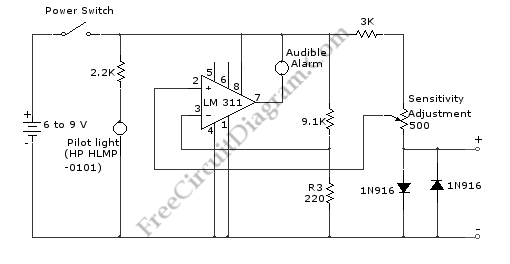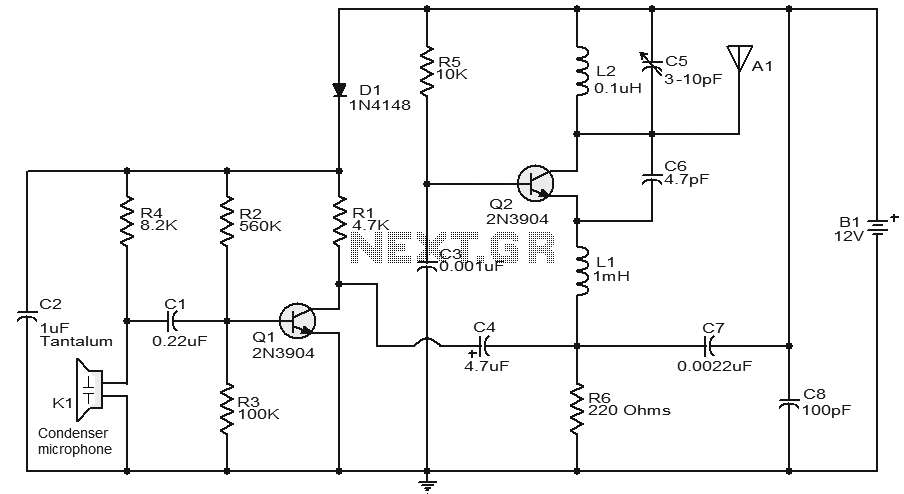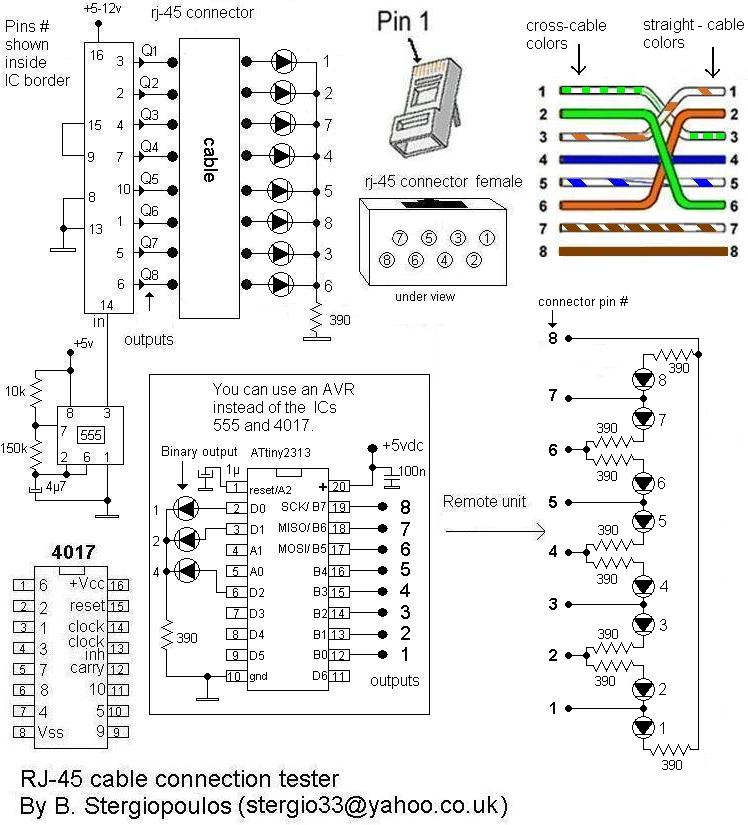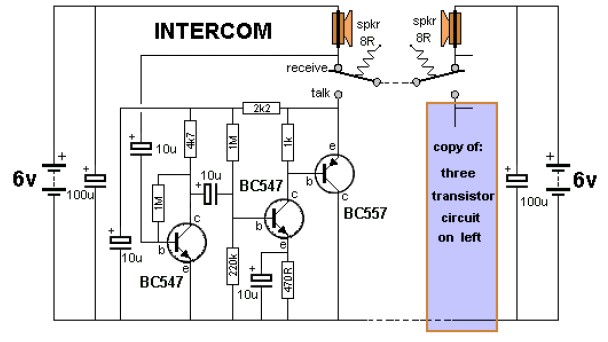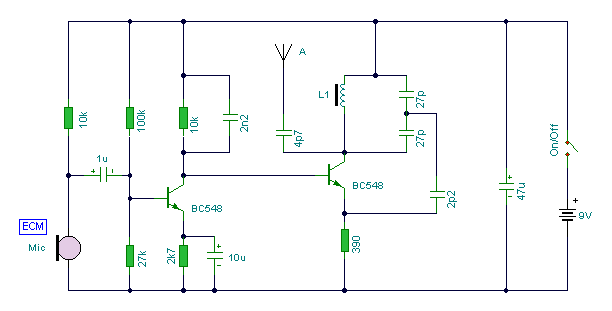
Cheap And Cheerful Transistor Tester
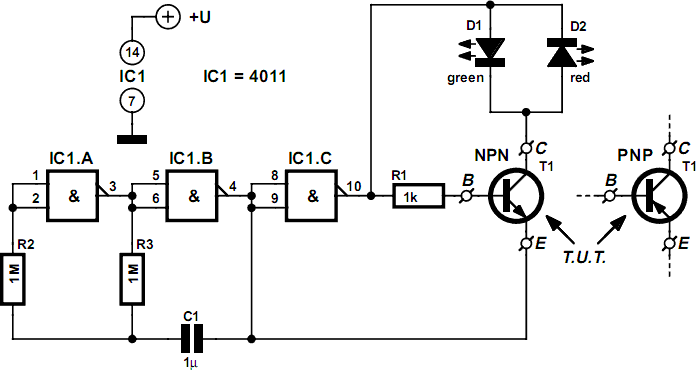
This small transistor tester employs a simple visual indication system to perform a quick go/no-go check on both NPN and PNP transistors. When testing a functioning NPN transistor, the green LED (D1) will flash, while the red LED will flash for a working PNP transistor. If the transistor is shorted, both LEDs will flash, and if the device is open-circuit, the LEDs will remain off. The circuit utilizes a CD4011B quad NAND gate IC, four passive components, and two LEDs. The fourth gate in the IC is unused and should have its inputs grounded. Alternatively, it can be connected in parallel with IC1.C to enhance the drive power of the transistor testing circuit. IC1.A and IC1.B, along with R2, R3, and C1, form an oscillator circuit that generates a low-frequency square wave at pin 4. This signal is applied to the emitter of the transistor under test and to inverter IC1.C. The inverted signal from IC1.C and the oscillator output drive the test circuit (LEDs, device under test, R1) in such a manner that the voltage across this part of the circuit is effectively reversed at all times. For instance, when testing an NPN transistor, if pin 10 is high and pin 4 is low, current flows through LED D1 and the forward-biased transistor. Conversely, no current flows when pins 10 and 4 switch states, as the transistor is then reverse-biased. Therefore, the green LED, D1, will flash at a rate determined by the oscillator. In the case of a PNP transistor, it will be forward-biased when pin 10 is low and pin 4 is high, allowing current to flow through the red LED. A supply voltage of around 3 V (using two series-connected 1.5 V batteries) is sufficient. To prevent damage to the transistor under test, supply voltages exceeding 4.5 V should be avoided. The output of IC1.C limits the LED currents to a few mA, which is slightly dependent on the supply voltage, making it advisable to use high-efficiency LEDs for D1 and D2.
The transistor tester circuit operates by utilizing a quad NAND gate IC (CD4011B) to create an oscillator that drives the testing process. The oscillator is formed by connecting two of the NAND gates (IC1.A and IC1.B) with resistors R2 and R3 and capacitor C1, generating a square wave signal at pin 4. This square wave signal alternates between high and low states, which is crucial for testing the transistors.
When an NPN transistor is inserted into the circuit, the arrangement allows current to flow through LED D1 when pin 10 is high and pin 4 is low, indicating that the transistor is functioning correctly. The reverse bias condition occurs when the states of pins 10 and 4 switch, preventing current flow and allowing the LED to flash in sync with the oscillator's frequency. The same principle applies to the PNP transistor, where the conditions for forward bias are reversed, resulting in the red LED flashing.
The circuit's design ensures that the LEDs are driven within safe current limits, thus protecting the transistors being tested. The recommended supply voltage is critical for the operation, as exceeding 4.5 V could damage the transistor. The use of high-efficiency LEDs is recommended to ensure bright illumination while minimizing power consumption. Overall, this simple yet effective transistor tester provides a reliable method for quickly assessing the functionality of both NPN and PNP transistors in a compact design.By using a simple visual indicating system, this small transistor tester allows you to run a quick go/non-go` check on NPN as well as PNP transistors. If the device under test is a working NPN then the green LED (D1) will‚ash, while the red counterpart will‚ash for a functional PNP device.
However if the transistor is shorted, both LEDs will ‚ash, and an open-circuit device will cause the LEDs to remain off. The circuit is based on just one CD4011B quad NAND gate IC, four passive parts and two LEDs. The fourth gate in the IC is not used and its inputs should be grounded. Alternatively, you may want to connect its inputs and output in parallel with IC1. C to increase its drive power to the transistor test circuit. IC1. A and IC1. B together with R2, R3 and C1 form an oscillator circuit that generates a low-frequency square wave at pin 4. This signal is applied to the emitter of the transistor under test as well as to inverter IC1. C. The inverted signal from IC1. C and the oscillator output then drive the test circuit (LEDs, device under test, R1) in such a away that the voltage across that part of the circuit is effectively reversed all the time.
For example, with an NPN transistor under test, when pin 10 is High and pin 4, Low, current‚ows through LED D1 and the forward biased transistor. However, no current will‚ow when pins 10 and 4 change states, since the transistor is then reverse-biased.
The green LED, D1, will therefore‚ash at the rate determined by the oscillator. As you would expect to happen, a PNP transistor will be forward biased when pin 10 is Low and 4, High, enabling current to‚ow through the red LED in that case. A supply rail of around 3 V (two series connected 1. 5-V batteries) should be adequate. To prevent damage to the transistor under test, supply voltages higher than 4. 5 V should not be used. Because the LED currents are effectively limited to a few mA by the output of IC1. C (also slightly dependent on the supply voltage), it is recommended to use high-efficiency devices for D1 and D2.
🔗 External reference
The transistor tester circuit operates by utilizing a quad NAND gate IC (CD4011B) to create an oscillator that drives the testing process. The oscillator is formed by connecting two of the NAND gates (IC1.A and IC1.B) with resistors R2 and R3 and capacitor C1, generating a square wave signal at pin 4. This square wave signal alternates between high and low states, which is crucial for testing the transistors.
When an NPN transistor is inserted into the circuit, the arrangement allows current to flow through LED D1 when pin 10 is high and pin 4 is low, indicating that the transistor is functioning correctly. The reverse bias condition occurs when the states of pins 10 and 4 switch, preventing current flow and allowing the LED to flash in sync with the oscillator's frequency. The same principle applies to the PNP transistor, where the conditions for forward bias are reversed, resulting in the red LED flashing.
The circuit's design ensures that the LEDs are driven within safe current limits, thus protecting the transistors being tested. The recommended supply voltage is critical for the operation, as exceeding 4.5 V could damage the transistor. The use of high-efficiency LEDs is recommended to ensure bright illumination while minimizing power consumption. Overall, this simple yet effective transistor tester provides a reliable method for quickly assessing the functionality of both NPN and PNP transistors in a compact design.By using a simple visual indicating system, this small transistor tester allows you to run a quick go/non-go` check on NPN as well as PNP transistors. If the device under test is a working NPN then the green LED (D1) will‚ash, while the red counterpart will‚ash for a functional PNP device.
However if the transistor is shorted, both LEDs will ‚ash, and an open-circuit device will cause the LEDs to remain off. The circuit is based on just one CD4011B quad NAND gate IC, four passive parts and two LEDs. The fourth gate in the IC is not used and its inputs should be grounded. Alternatively, you may want to connect its inputs and output in parallel with IC1. C to increase its drive power to the transistor test circuit. IC1. A and IC1. B together with R2, R3 and C1 form an oscillator circuit that generates a low-frequency square wave at pin 4. This signal is applied to the emitter of the transistor under test as well as to inverter IC1. C. The inverted signal from IC1. C and the oscillator output then drive the test circuit (LEDs, device under test, R1) in such a away that the voltage across that part of the circuit is effectively reversed all the time.
For example, with an NPN transistor under test, when pin 10 is High and pin 4, Low, current‚ows through LED D1 and the forward biased transistor. However, no current will‚ow when pins 10 and 4 change states, since the transistor is then reverse-biased.
The green LED, D1, will therefore‚ash at the rate determined by the oscillator. As you would expect to happen, a PNP transistor will be forward biased when pin 10 is Low and 4, High, enabling current to‚ow through the red LED in that case. A supply rail of around 3 V (two series connected 1. 5-V batteries) should be adequate. To prevent damage to the transistor under test, supply voltages higher than 4. 5 V should not be used. Because the LED currents are effectively limited to a few mA by the output of IC1. C (also slightly dependent on the supply voltage), it is recommended to use high-efficiency devices for D1 and D2.
🔗 External reference
